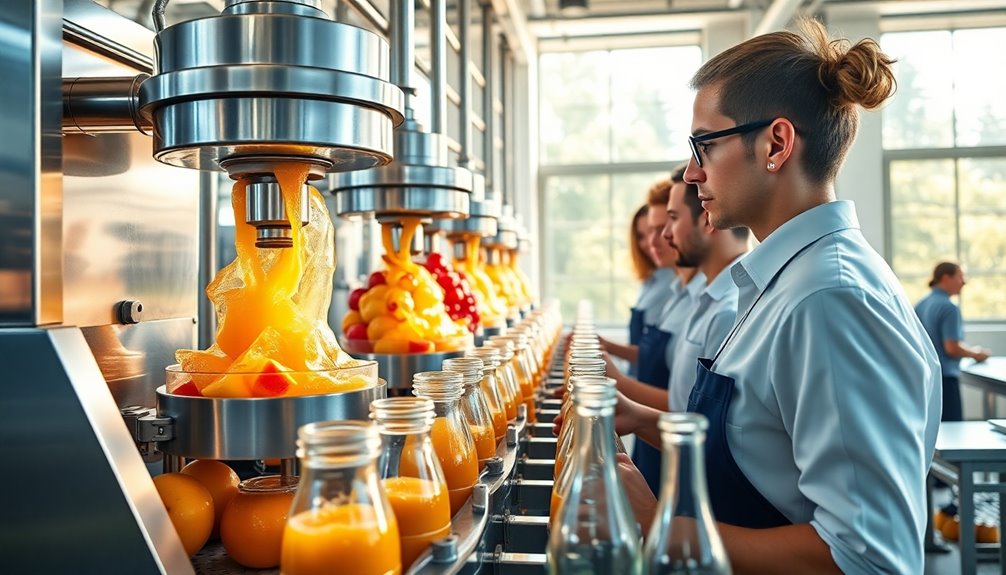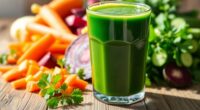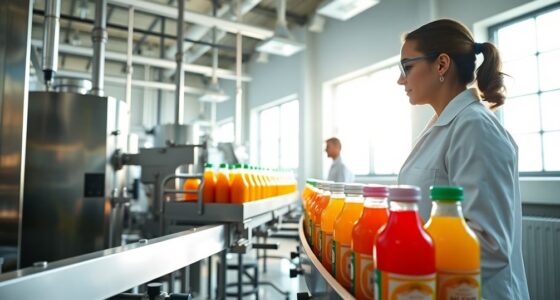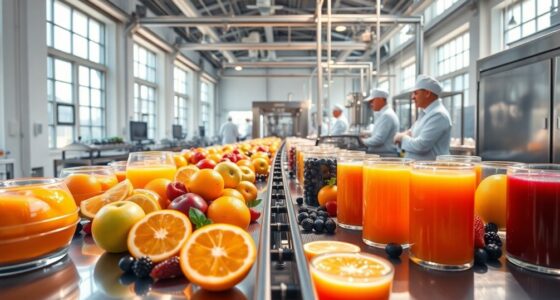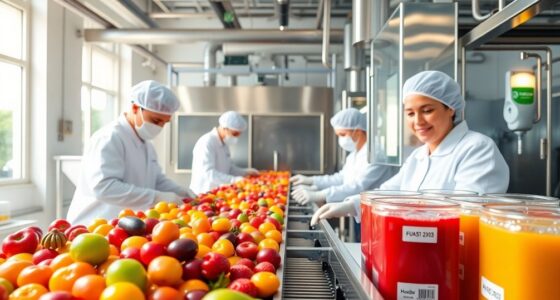To boost efficiency in juice production, harvest fruits at peak maturity and quickly process them to preserve nutrients. Wash and select quality produce to maintain flavor. Use cold pressing for juice extraction and advanced bottling machines for faster output. Implement HACCP measures to guarantee safety. Don't forget to explore by-product valorisation to cut waste and enhance sustainability. With the right practices in place, you can truly optimize your production process and discover more tips along the way.
Key Takeaways
- Harvest fruits at peak maturity and process quickly to preserve vitamins and enhance juice quality.
- Utilize cold press extraction to retain nutrients while improving flavor and clarity.
- Implement HACCP protocols to identify hazards and ensure food safety throughout production.
- Invest in high-capacity bottling machines for increased output and reduced contamination risks.
- Convert by-products into valuable materials, minimizing waste and enhancing sustainability in production.
Harvesting Techniques for Optimal Yield
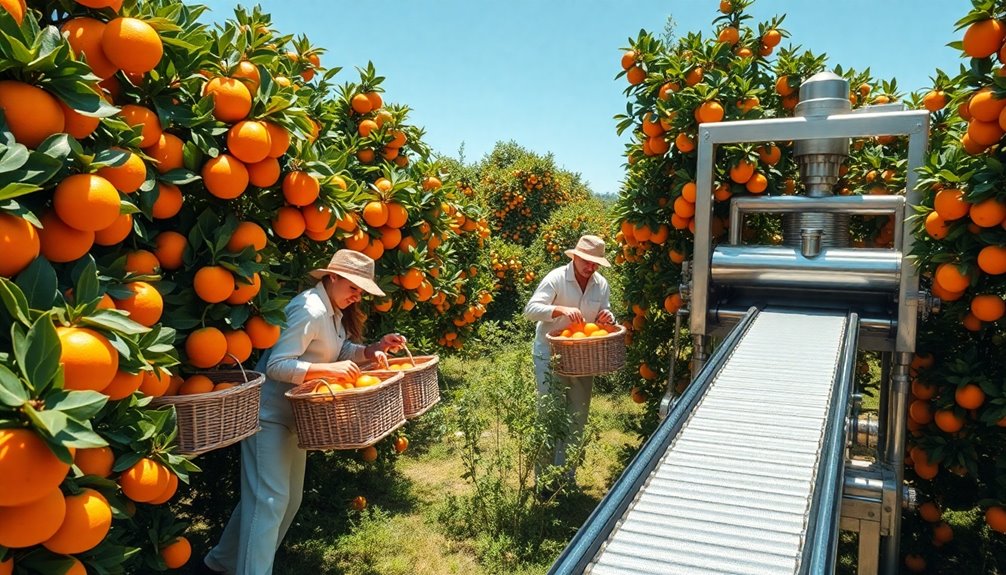
When you harvest fruits and vegetables at their peak maturity, you guarantee the highest quality juice and minimize waste. Using effective harvesting techniques is key to maximizing your yield.
Quick processing post-harvest, ideally within hours, helps preserve essential vitamins, ensuring your fruit products maintain their nutritional content. Implement quality assurance measures during harvesting to select only the best fruits for juice production, enhancing both flavor and safety.
Timing matters too; for instance, citrus fruits should be harvested when they hit the ideal sugar-to-acid ratio for peak taste.
Consider mechanical harvesters to streamline your process, boosting efficiency while cutting down on labor costs and time. This approach not only elevates your juice quality but also optimizes your overall production efforts.
Importance of Washing and Selection
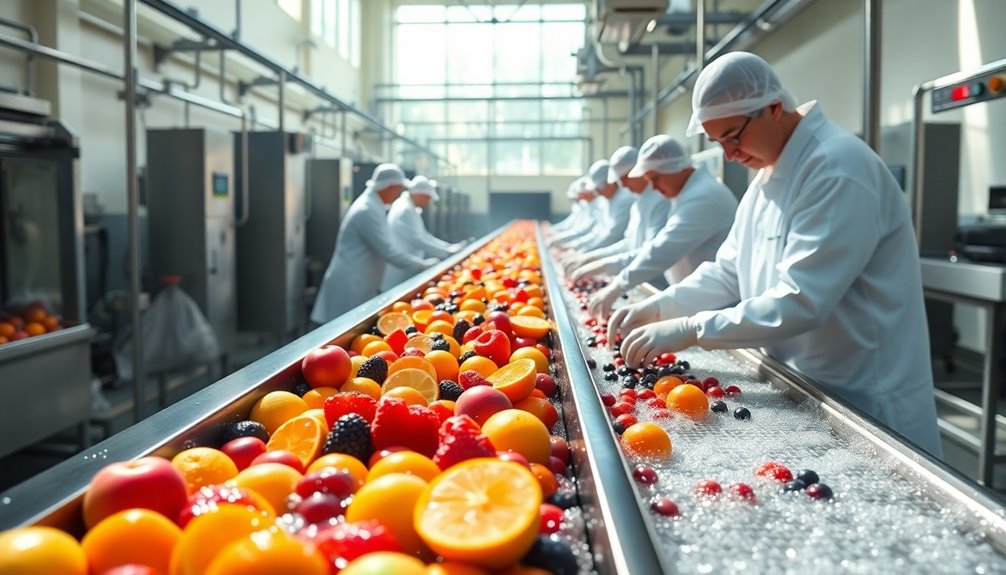
After harvesting fruits and vegetables at their peak, washing and selection become essential steps in the juice production process.
You'll want to wash the produce with cold running water to effectively remove dirt, dust, and pesticides, ensuring the safety and quality of your final juice.
During the selection phase, it's important to reject suboptimal fruits that could compromise flavor and quality. This not only enhances your product but also aligns with HACCP regulations, ensuring compliance with food safety standards.
Additionally, proper calibration during washing can maximize yield, especially in citrus fruits, while effective practices extend shelf life, reduce food waste, and contribute to overall efficiency in your juice production.
Prioritizing these steps is critical for a successful operation.
Juice Extraction Methods Explained
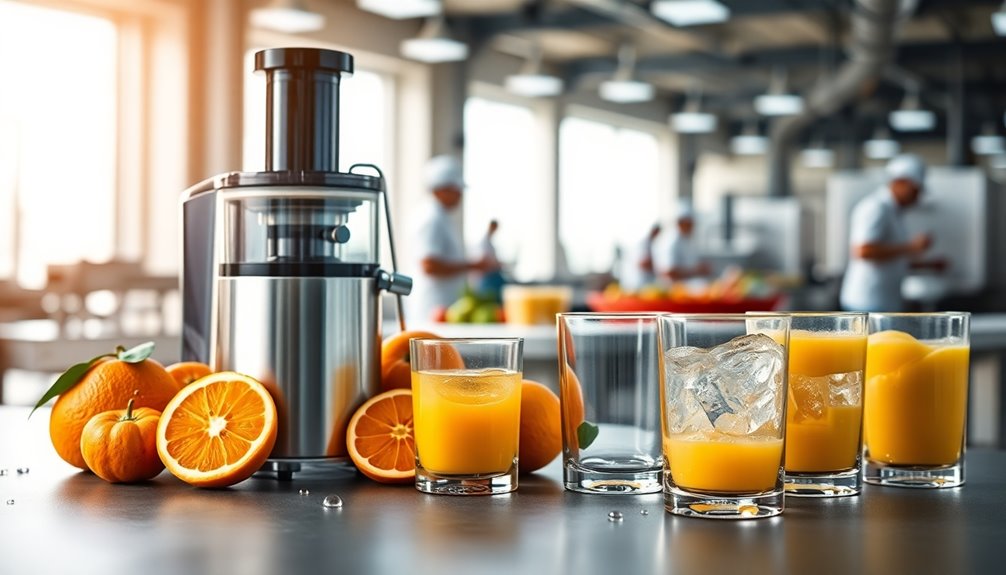
When it comes to extracting juice, the method you choose can make a big difference in taste and nutrition.
For citrus fruits, squeezing helps you avoid bitter oil flavors while ensuring a fresh taste.
On the other hand, cold pressing retains more nutrients from other fruits and veggies, giving you a richer flavor profile. Additionally, the extraction process significantly influences the overall quality and nutritional value of the juice produced.
Cold Press Extraction Benefits
Cold press extraction offers a unique advantage in juice production, as it preserves essential vitamins, minerals, and enzymes that heat can destroy.
This cold pasteurization technique guarantees food safety while extracting maximum juice yield. By pressing fruits and vegetables without heat, you maintain the integrity of their cellular structure, resulting in a richer flavor and smoother texture.
You'll notice less oxidation and foam, enhancing the overall sensory experience. This method shines with nutrient-dense vegetables like kale and spinach, allowing them to release more phytonutrients and chlorophyll.
As a juice manufacturer, using cold press techniques caters to health-conscious consumers seeking minimally processed, nutrient-rich beverages.
Embrace this efficient method to elevate your juice production process!
Citrus Juice Squeezing Techniques
Juice extraction techniques vary greatly across different fruits, and citrus fruits require specific methods to guarantee a pure, vibrant flavor. Squeezing is the primary method for extracting citrus juice, as it prevents the undesirable taste of oils from the peel.
Utilizing specialized equipment during processing helps you achieve ideal yield while minimizing waste and maximizing juice quality. Cold pressing is another effective technique that applies high pressure to extract juice without heat, preserving essential nutrients.
It's important to process citrus fruits quickly after harvesting to maintain flavor integrity and nutritional value. Calibrating your equipment during extraction is critical, particularly for citrus, to avoid unnecessary oil extraction and make sure you get the best quality juice possible.
Streamlining the Bottling Process
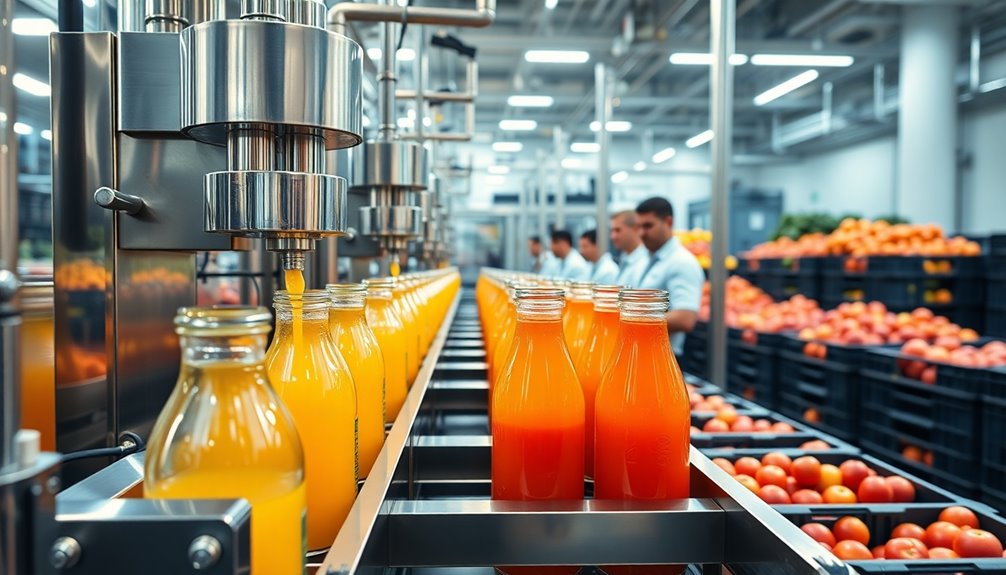
To streamline the bottling process, you'll want to focus on machine efficiency and quality assurance measures.
Investing in high-capacity bottling machines can drastically increase your output while maintaining product integrity. Additionally, ensuring that your juice retains its nutritional advantages during processing can enhance the final product's appeal to health-conscious consumers.
Bottling Machine Efficiency
When streamlining the bottling process, efficiency is key to maximizing production. In the juice industry, utilizing a bottling machine with up to 120 filling heads can boost your output to 1,000 units per minute, considerably enhancing throughput.
Incorporating hands-free pressure capping devices minimizes manual labor and reduces contamination risks, which is essential for maintaining product integrity. Furthermore, using food-grade bottles that don't require cleaning eliminates unnecessary sanitation steps, saving both time and resources.
Implementing advanced technology from manufacturers like Zumex and Goodnature guarantees consistency and reliability in your operating procedures, further contributing to overall efficiency. By focusing on these aspects, you'll optimize your bottling process and preserve the quality of your juice.
Quality Assurance Measures
Streamlining the bottling process not only boosts efficiency but also demands robust quality assurance measures to maintain product integrity.
Utilizing hands-free pressure capping devices minimizes contamination risks, enhancing product safety. Bottling machines with up to 120 filling heads can achieve impressive production rates of 1,000 units per minute, but without proper quality checks, consistency suffers.
Implementing quality assurance protocols during bottling, like monitoring fill levels and capping integrity, guarantees each bottle meets standards. Additionally, using food-grade bottles that don't require cleaning cuts down sanitation labor costs.
Regular maintenance of your bottling equipment is essential, too, as it prevents downtime and keeps operations running smoothly. In the competitive food industry, these measures are critical for success. Furthermore, regular filter replacement is vital in maintaining equipment efficiency, ensuring optimal performance throughout the production process.
Preparing Products for High Pressure Processing

Preparing products for High Pressure Processing (HPP) is essential to ensuring that your juice retains its nutritional value while meeting safety standards.
Start by using food-grade bottles that don't require cleaning, as this is critical for product safety and maintaining quality. It's important to maintain aseptic conditions during bottling to prevent any microbial contamination.
With HPP technology, you effectively eliminate harmful microorganisms like Salmonella and E. coli, achieving the FDA-mandated 5-log reduction.
Regularly monitor and sample your products before and after HPP to verify pathogen reduction, which is a key component of your HACCP Plan.
Implementing HACCP for Quality Assurance
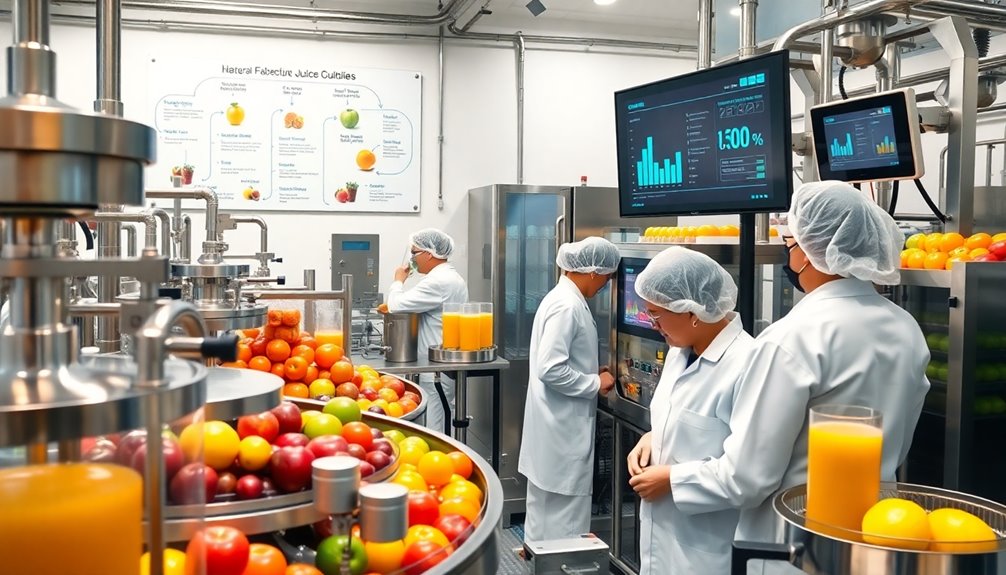
When you implement a HACCP plan, identifying hazards is essential for ensuring juice safety.
You'll need to monitor critical control points throughout the production process to prevent any risks.
Hazard Identification Strategies
A well-implemented HACCP plan can greatly enhance juice production quality by systematically identifying potential hazards.
Start by focusing on hazard identification strategies that target microbial contaminants like E. coli and Salmonella, which can linger in improperly managed juice. Regular sampling points—such as raw material reception, processing equipment, and post-pasteurization—are vital for effective food safety.
To comply with FDA juice HACCP regulations, guarantee a 5-log reduction in resistant pathogens, reducing the risk of juice-related outbreaks. Your HACCP plan should include Standard Operating Procedures (SOPs) for managing biological, chemical, and physical hazards.
Finally, maintain thorough documentation of supply chain safety, including Certificates of Analysis (COA) and allergen statements, to reinforce hazard control beyond your internal processes.
Monitoring Critical Control Points
To guarantee the highest quality and safety in juice production, monitoring critical control points (CCPs) is essential. Start by identifying these CCPs, such as raw material reception and post-pasteurization.
Regularly sample incoming fruits to assess microbial load and prevent contamination right from the beginning. The FDA requires a 5-log reduction in resistant pathogens, so rigorous microbial monitoring at each CCP guarantees compliance and enhances food safety.
Keep detailed monitoring records to document actual values observed, guaranteeing traceability and accountability throughout the production process.
Establish standard operating procedures (SOPs) for every identified hazard, including biological, chemical, and physical risks, to maintain safe and sanitary processing conditions. This systematic approach is key for effective quality assurance in juice production, as antioxidants combat oxidative stress and contribute to overall food safety and health benefits.
Enhancing Juice Clarity and Quality
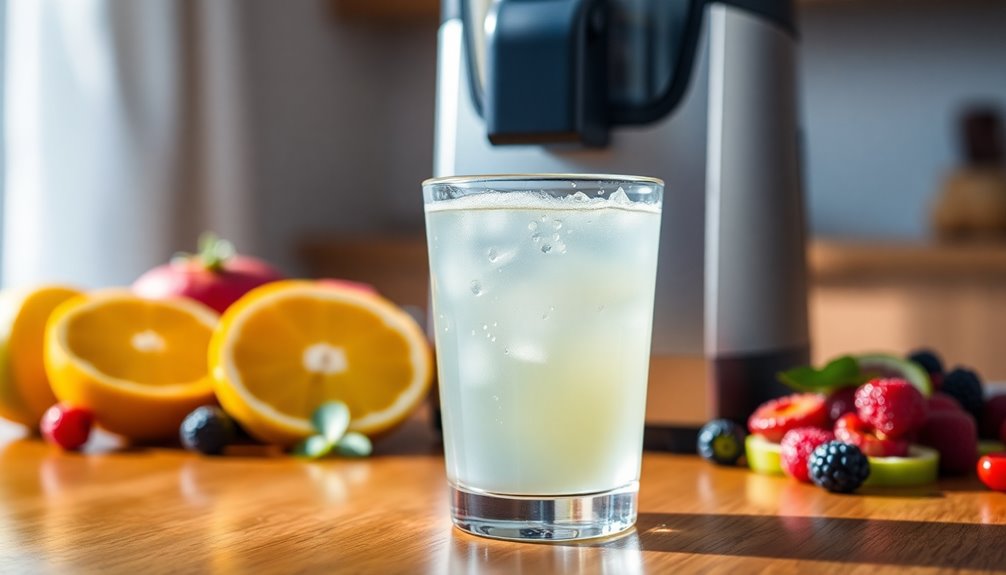
Achieving high juice clarity and quality hinges on the careful selection of raw materials, as cloud particles can greatly impact the final product.
To enhance juice clarity, focus on the extraction, mash enzymation, and clarification phases of processing. These steps are essential for managing turbidity levels and ensuring a smooth outcome.
Implement effective filtration techniques to remove sediment and secondary hazing, which enhances the visual appeal of your juice.
By monitoring and controlling turbidity and sedimentation throughout production, you'll remarkably boost the overall quality and consumer appeal of your juice.
Adopting best practices in juice clarity processing can lead to a cleaner, more attractive final product, ultimately improving marketability and customer satisfaction.
By-Product Valorisation for Sustainability
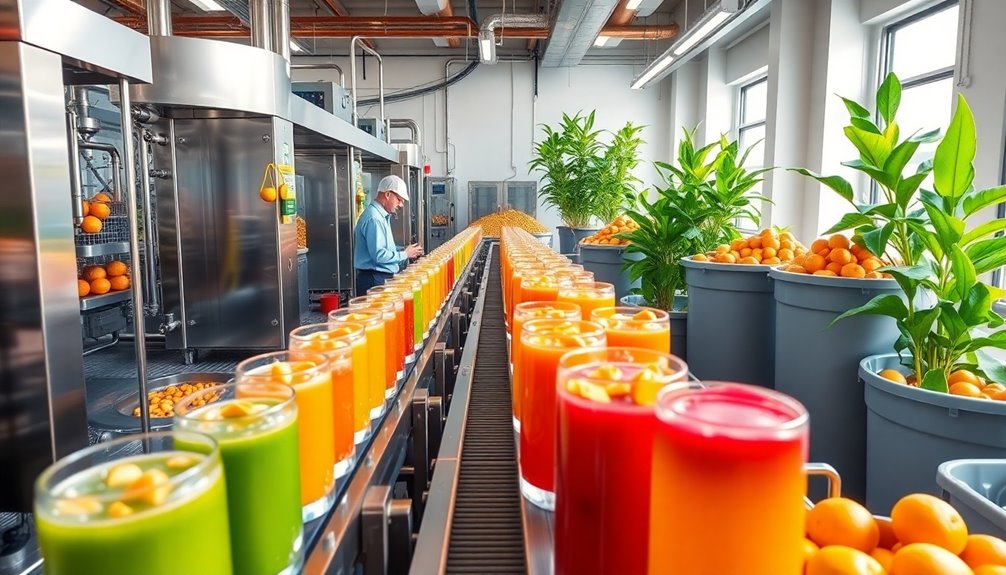
While many juice producers focus solely on the juice itself, by-product valorisation can greatly enhance sustainability efforts. By converting waste materials like fruit peels and pulp into sustainable energy or valuable products, you're boosting resource efficiency.
By implementing circular economy principles, you can utilize about 50-70% of by-products from fruit processing, markedly cutting down waste and environmental impact. Techniques such as anaerobic digestion can transform organic waste into biogas for energy generation, aligning with your sustainability goals.
Additionally, extracting bioactive compounds like antioxidants and dietary fibers from by-products allows you to market these as health supplements or food additives. Notably, butter's low sugar content highlights that by-products can be an excellent source of nutrients without significantly impacting blood sugar levels.
Collaborating with research institutions and industry partners can further enhance the economic feasibility and profitability of your by-product valorisation projects.
Technological Innovations in Juice Manufacturing
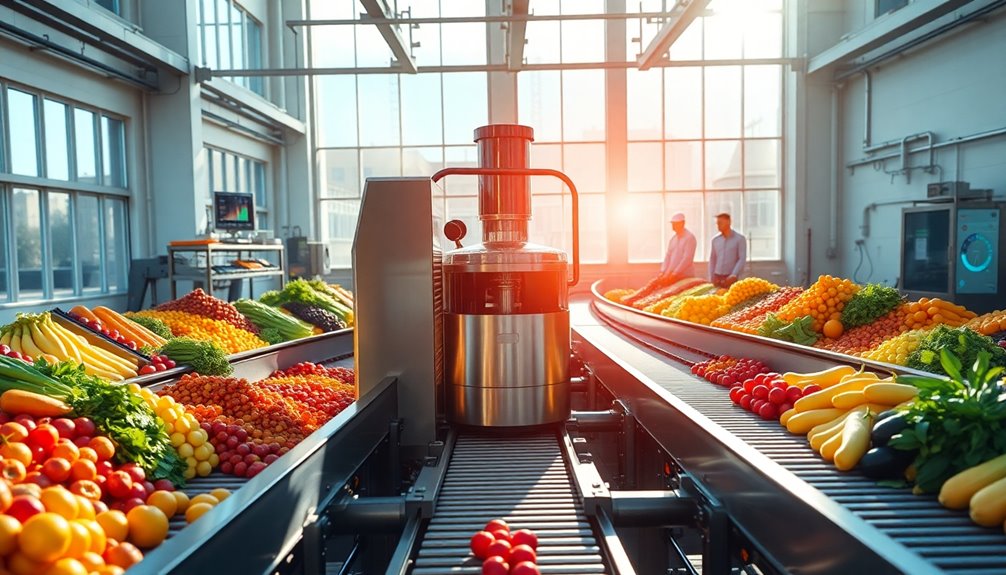
As juice manufacturers embrace cutting-edge technology, they're finding innovative ways to enhance efficiency and product quality.
Technological innovations like High Pressure Processing (HPP) extend shelf life without heat, preserving nutritional properties and catering to the rising demand for cold-pressed juices.
Automated bottling machines, such as those from Zumex and Goodnature, boost productivity by handling up to 1,000 units per minute, minimizing labor costs.
Enhanced pulping machines guarantee ideal flavor by efficiently removing stones from fruits.
Additionally, ozone treatment in washing technologies reduces residual chlorate levels, elevating food safety.
Aseptic processing allows juice to be packaged under sterile conditions at room temperature, increasing shelf life up to 18 months without refrigeration while providing flexibility in container design.
Staff Training and Best Practices for Efficiency
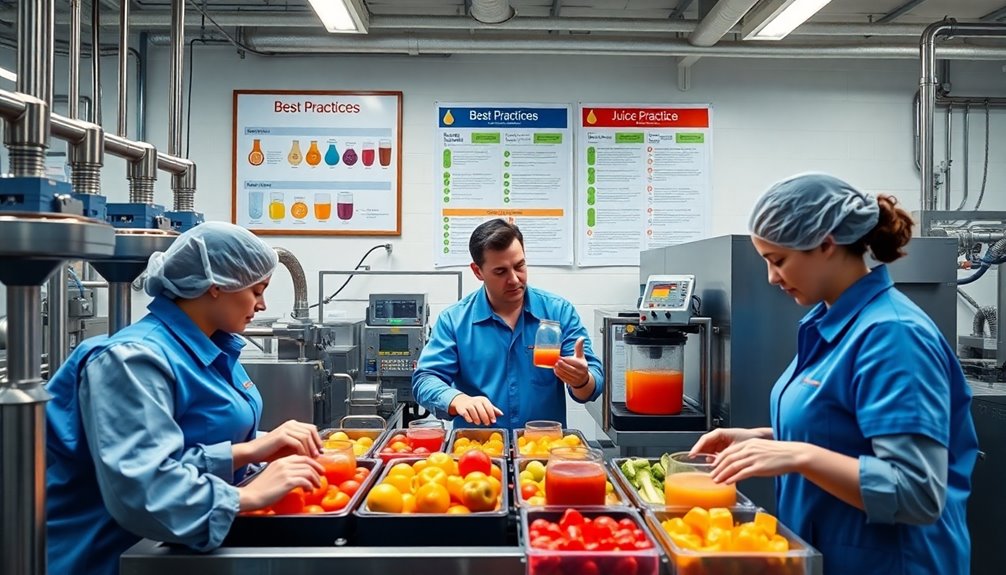
Technological advancements in juice production can only go so far without a well-trained workforce to support them.
Prioritizing staff training is essential for maintaining food safety and adhering to HACCP principles. Here are key best practices to implement:
- Regular HACCP Training: Guarantee all staff understand critical control points and food safety regulations.
- Standard Operating Procedures: Use SOPs for processes like fruit washing and bottling to minimize contamination risks.
- Monitoring Records: Encourage accurate logs for temperature and sanitation checks to enhance traceability.
- Cross-Training: Provide opportunities for employees to learn various roles, improving flexibility during peak times.
Frequently Asked Questions
What Is the FDA Regulation for Juice HACCP?
The FDA regulation for juice HACCP mandates that you implement a plan ensuring a 5-log reduction of harmful pathogens like E. coli and Salmonella.
This applies to all juice processors, except for those selling directly to consumers.
You must systematically identify potential hazards and critical control points throughout your production process.
Regular monitoring and documentation are essential to maintain compliance with HACCP requirements, ensuring food safety and adherence to regulatory standards.
What Are the Steps of Juice Production?
Juice production's like crafting a fine symphony; every step matters.
You start with harvesting fruits at their peak, then wash and select the best ones to guarantee quality.
Next, you extract juice using methods tailored to each fruit type.
After that, you bottle the juice with precision, often using machines that can fill up to 1,000 bottles per minute.
Finally, you may apply High Pressure Processing to enhance shelf life while keeping flavors intact.
What Are the Parameters for Fruit Juice Quality?
When it comes to fruit juice quality, you need to contemplate several key parameters.
First, the maturity of the fruit plays a crucial role in flavor and yield. You should wash the fruits with cold running water to remove contaminants.
For extraction, tailor your method to the fruit type—squeeze citrus and press others.
Implementing High Pressure Processing (HPP) can extend shelf life while maintaining nutritional value, ensuring your juice stays fresh and safe.
What Are the Basic Principles of Juice Extraction?
When you think about juice extraction, consider the methods, the timing, and the equipment.
You'll want to choose the right extraction technique for each fruit, ensuring you maintain flavor and quality. You must process the fruit quickly after harvesting to keep its vitamins intact.
Using a calibrated approach prevents undesirable elements from affecting taste, while a pulping machine can help achieve a smooth consistency by efficiently removing stones.
Conclusion
In the whirlwind of juice production, every drop counts. By implementing these guidelines, you’re not just enhancing efficiency; you’re crafting liquid sunshine that brings joy to consumers. Embrace the art and science of juice making, and watch your process transform into a symphony of flavor and sustainability. Remember, each step you take not only boosts your yield but also nourishes the world. So, roll up your sleeves and let your passion for juice creation flow! By focusing on optimal juice production practices, you ensure that your product not only tastes great but also aligns with eco-friendly initiatives. This holistic approach allows you to minimize waste and maximize the quality of your juice, resulting in a delightful experience for your customers. As you refine your techniques, you will discover new flavors and combinations that inspire both you and your audience, turning every batch into a celebration of nature’s bounty.
Cindy thoroughly researches juicing trends, techniques, and recipes to provide readers with practical advice and inspiration. Her writing style is accessible, engaging, and designed to make complex concepts easy to understand. Cindy’s dedication to promoting the advantages of juicing shines through her work, empowering readers to make positive changes in their lives through the simple act of juicing.

